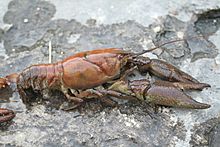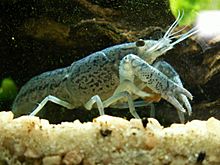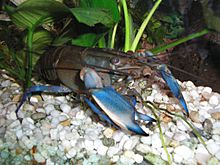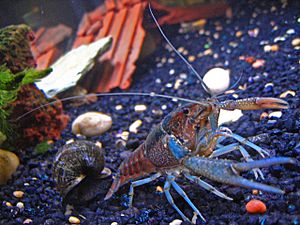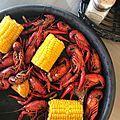Crayfish facts for kids
Quick facts for kids Crayfish |
|
|---|---|
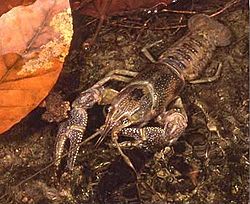 |
|
| Scientific classification | |
| Kingdom: | |
| Phylum: | |
| Class: | |
| Subclass: | |
| Order: | |
| Suborder: |
Pleocyemata
|
| Infraorder: |
Astacidea
|
| Superfamily: | |
| Families | |
|
Astacoidea |
|
Crayfish are amazing freshwater animals. They are also known as crawfish, crawdads, mudbugs, or yabbies. These creatures look a lot like small lobsters, and they are actually related!
Crayfish breathe using special feather-like gills. You can find them in many places. Some live in fast-moving brooks and streams. Others prefer slow-moving water like swamps, ditches, and even rice fields. Most crayfish need clean water to survive. They eat both plants and animals, and also dead bits of food called detritus. There are over 540 different types of crayfish around the world. About 150 of these species live in North America.
Contents
What Does a Crayfish Look Like?
A crayfish is a type of decapod crustacean. This group also includes crabs, lobsters, and shrimp. A crayfish's body has twenty body segments. These segments are grouped into two main parts: the cephalothorax (which is like a head and chest combined) and the abdomen (the tail part).
Each segment can have a pair of appendages, like legs or claws. Crayfish usually grow to about 17.5 centimeters (7 inches) long. Their walking legs have a small claw at the end.
Where Do Crayfish Live Around the World?
Scientists group crayfish into three main families. Two families live in the Northern Hemisphere, and one lives in the Southern Hemisphere.
The family called Parastacidae lives in the Southern Hemisphere. You can find them in South America, Madagascar, and Australasia (like Australia and New Zealand). They are special because they don't have the first pair of pleopods (small leg-like parts under their tail).
The other two families are Astacidae and Cambaridae. Astacidae crayfish live in western Eurasia and western North America. Cambaridae crayfish live in eastern Asia and eastern North America.
Crayfish in North America
North America has the most different kinds of crayfish. Over 330 species live there, especially in the southeastern United States.
In 1983, the state of Louisiana made the crayfish its official state crustacean. Louisiana is famous for its crayfish. It produces about 100 million pounds of crayfish every year! The main types harvested are the red swamp crayfish and the white river crayfish.
Crayfish are a big part of Cajun culture in Louisiana. People have even created small businesses selling things like crayfish-themed T-shirts, jewelry, and decorations.
Crayfish in Australia
Australia has over 100 species of crayfish. It is home to the world's three largest freshwater crayfish:
- The Tasmanian giant freshwater crayfish can weigh over 5 kilograms (11 pounds)! It lives in rivers in northern Tasmania.
- The Murray crayfish can reach 2.5 kilograms (5.5 pounds). Some have even been reported at 3 kilograms (6.6 pounds). It lives in the southern Murray-Darling basin.
- The marron from Western Australia can weigh up to 2.2 kilograms (4.8 pounds).
Many well-known Australian crayfish belong to the Cherax group. These include the common yabby and the red-claw crayfish.
Sadly, the marron species is critically endangered. This means it is at a very high risk of disappearing forever. Other large Australian crayfish are also threatened or endangered.
Crayfish in New Zealand
In New Zealand, there are two unique species of Paranephrops. They are known by their Māori name, kōura.
Other Animals Called "Crayfish"
Sometimes, the word "crayfish" can be confusing! In Australia, New Zealand, and South Africa, "crayfish" often means a saltwater spiny lobster. These lobsters are found in the ocean. The freshwater species in these places are usually called yabbies or kōura.
In Singapore, "crayfish" usually refers to Thenus orientalis, which is a type of seawater slipper lobster. True freshwater crayfish are not native to Singapore. However, people keep them as pets, and sometimes they escape into local waters. There, they are also called freshwater lobsters.
How Old Are Crayfish?
Finding fossils of crayfish older than 30 million years is rare. But scientists have found fossilized burrows (holes they dig) that are much older. Some burrows are from the late Palaeozoic or early Mesozoic eras.
The oldest crayfish fossils from the Parastacidae family are from Australia and are 115 million years old. The crayfish Palaeocambarus and Cricoidoscelosus from China are likely around 120 million years old. This makes them some of the oldest known crayfish!
How Do People Use Crayfish?
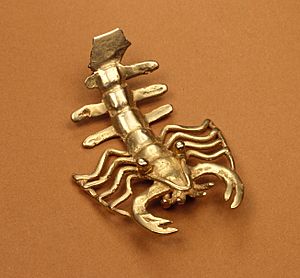
Crayfish as Food
People eat crayfish all over the world. Like other edible crustaceans, only a small part of the crayfish is eaten. In dishes like soups or stews, usually only the tail meat is used. At a "crawfish boil," where the whole crayfish is served, people might also eat the meat from the claws.
Crayfish are not kosher food. This means they are not eaten by observant Jews.
In 2005, Louisiana supplied 95% of the crayfish harvested in the U.S. In 1987, Louisiana produced 90% of the world's crayfish! Most of this was eaten right there in Louisiana. Today, about 70-80% of Louisiana's crayfish are the red swamp crawfish. The rest are white river crawfish.
Crayfish as Bait
Many fish like to eat crayfish. Because of this, crayfish are often used as bait by people who go fishing. Anglers use them to catch fish like catfish, largemouth bass, smallmouth bass, striped bass, and pike. When using live crayfish as bait, fishers often hook them between the eyes. This doesn't hurt the crayfish and keeps them active.
Crayfish as Pets
Crayfish can be kept as pets in freshwater aquariums. They enjoy eating shrimp pellets or vegetables. They will also eat tropical fish food, algae wafers, and even small fish they can catch with their claws.
It's important to be careful with pet crayfish. In many countries, like the United Kingdom, United States, Australia, and New Zealand, releasing pet crayfish into local rivers can be very harmful. If a crayfish from one river is released into a different one, it can cause big problems for the natural environment. For example, some crayfish can spread diseases like crayfish plague in Europe. Or, they can become an invasive species and harm the local ecosystem.
Crayfish as Invasive Species
Crayfish can become an invasive species. This means they spread to new places where they don't naturally belong. When this happens, they can cause problems for the local plants and animals. For example, some crayfish from Louisiana have become invasive in Europe and China. In China, they have even been known to eat local rice crops.
Images for kids
See also
 In Spanish: Cangrejo de río para niños
In Spanish: Cangrejo de río para niños


